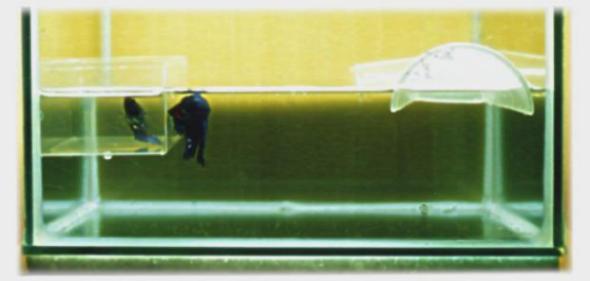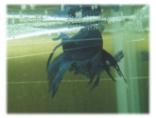|
|
|
Many people have complained that they encountered problems in trying to get their bettas to spawn. Bettas are by nature violent fishes. Males cannot coexist together and will fight to their deaths when placed together. Females too have the unfortunate tendency to fight amongst themselves. When a single male female(s) are placed in the same tank, it is common for the male to attack the female(s), although there are recorded instances of aggressive females battering their male counterparts.
Personally, I have spawned more bettas than I cared to count. To help new hobbyists avoid the many pitfalls in breeding the bettas, I have documented below the methodology that I adopted. They are just suggestions by personal experience, steps that are generally applicable. Due to the varying characteristics, traits and genetic background of the fish, there will be times when a judgement call needs to be made and modifications applied to the flow below.
Episode 1: The prelude
A breeding pair is selected. The pair
has to be conditioned to full spawning capability. This means a period
of multiple feedings a day, preferably with live food. With proper
care, most females should be ready within 3 weeks. The keyword here
is patience, patience and more patience. I have seen too many cases
of the over enthusiatic aquarist introduce the intended breeding pair to
each other before either is ready. The end result is almost always
an aborted spawning attempt and two injured fishes. The female at
the time of mating should ideally be swollen with eggs. Swollen as
in she appears to be bursting from eggs. The more accomplished breeder
can probably make do with less ready females. I have read that black
water extract helps to spur them into breeding mood, but personally never
needed to do that. There are cases where the intended breeding female
is bigger than the male. Such pairing should be avoided if possible
as the male may find it difficult to position himself for a complete "wrap"
of the female. This in turn may reduce the chances of the eggs being
fertilized.
Episode 2: Building a future
Place the male in a tank with about 15 cm deep water and a place for him to build his nest. Some breeders use floating plants to help the male anchor his nest. I artificially create the anchor point by cutting a party cup into half (from top to bottom) and then taping the half cup to the edge of the tank. Most of the time, the male will build his nest in the sanctuary of this cup. The cup will help shelter the nest from drafts and other water disturbances. Any water agitation at this stage could be detrimental to the male's efforts to build a coherent nest.

Breeding tank setup.
Episode 3: Get-together
The next phase is to introduce the female to the male. I always do a indirect introduction first by placing the female in a jar and then put the jar in the breeding tank. The jar is normally only half filled having high walls that prevent either fish from jumping in or out, and at the same time, the female has no problems reaching the surface for air. This indirect introduction may take place concurrently with the male building the nest. Depending on the fishes, the sight of a female can either spurs the male into building a nest faster, or simply just distract him from his job, so the breeder has to react accordingly.
When the female shows that she subverts to the male, by showing very distinct vertical stripes/bars and at times a drooping head, it is time to physically introduce her to the breeding tank. It does not matter how dark of colourful the female is before mating session, her strips will be very visible. There may be identification problems when it comes to light bodied fishes though.
The actual introduction of the female into the breeding tank is a crucial time and one should always pay close attention. Normally, the male will chase and nip at the female. However occasionally, the female wins and abuses her mate instead. More often than not, one ends up with two fishes with very tattered and torn fins. If one party is losing the battle really badly (usually the female), the hobbyist should remove the victim and maybe condition a different fish to try again. A little hiding space (such as a clump of java moss) for the losing party goes a long way to preserving the victim's life. How badly is "too bad" is difficult to describe, it is better for the hobbyist to judge for himself. Some pairs get into the spawning act quickly without any fights, others will shred each other's fins until there are none left. Whatever it is, spawning should take place within 48 hours. My habit is to introduce the female at night, just before lights out, and spawning normally takes place the following day.
Just before breeding, the female (with vertical stripes on) will tend to swim towards the male and his nest. The actual mating almost always take place directly below the nest. The male will wrap his body around the female, attempting to fertilize the eggs that the female betta releases from her body. For each wrap, the female will release a few eggs which will sink to the bottom of the tank. Both fishes will appear to be stunned for a few seconds after each spawning attempt. Normally, the male recovers first and swims to the bottom of the tank to pick up eggs and blow them into the nest. It will be very helpful to the male if the tank is bare bottomed. After the female recovers, she too will swim to the bottom of the tank and search for any eggs that the male fail to find. There is a tendency for females to eat any eggs that they can find, though sometimes females help their hubby to put the eggs into the nest. This cycle repeats itself until the female runs out of eggs or something interrupts the mating session. The male betta will chase the female away from the nest once breeding is completed.


On the left, we have the male
embracing the female and we can see
eggs (the white specks) dropping
from the entwined pair on the right.
Episode 4: The fad shows his true colours
The female should be removed immediately
after the mating is completed. Otherwise she will most likely be
battered to death.
Episode 5: Fads can be good fathers
The newly crowned father will guard his nest
for the next few days. He will constantly repair his nest.
Eggs that fall from the nest will be dutifully caught and blown back into
the nest. Breeding is now over, but the hobbyist is faced with the
titanic task of raising the fries.
The above are just rough guidelines that
I use. Different breeding pairs are known to act differently.
Good luck!